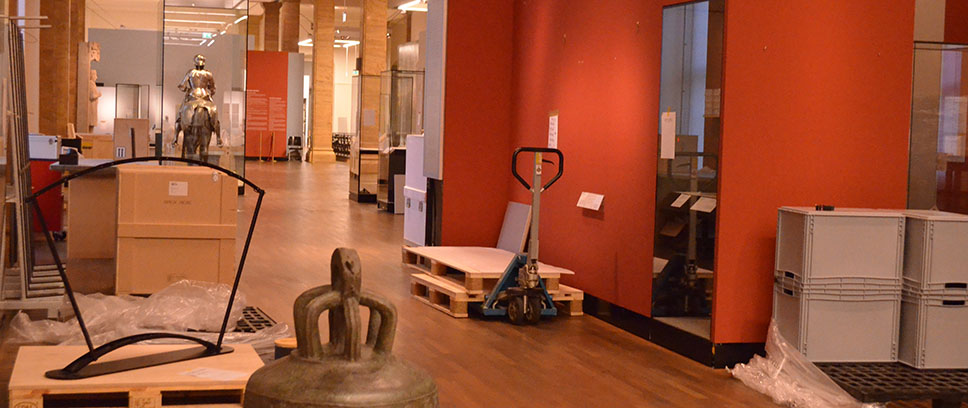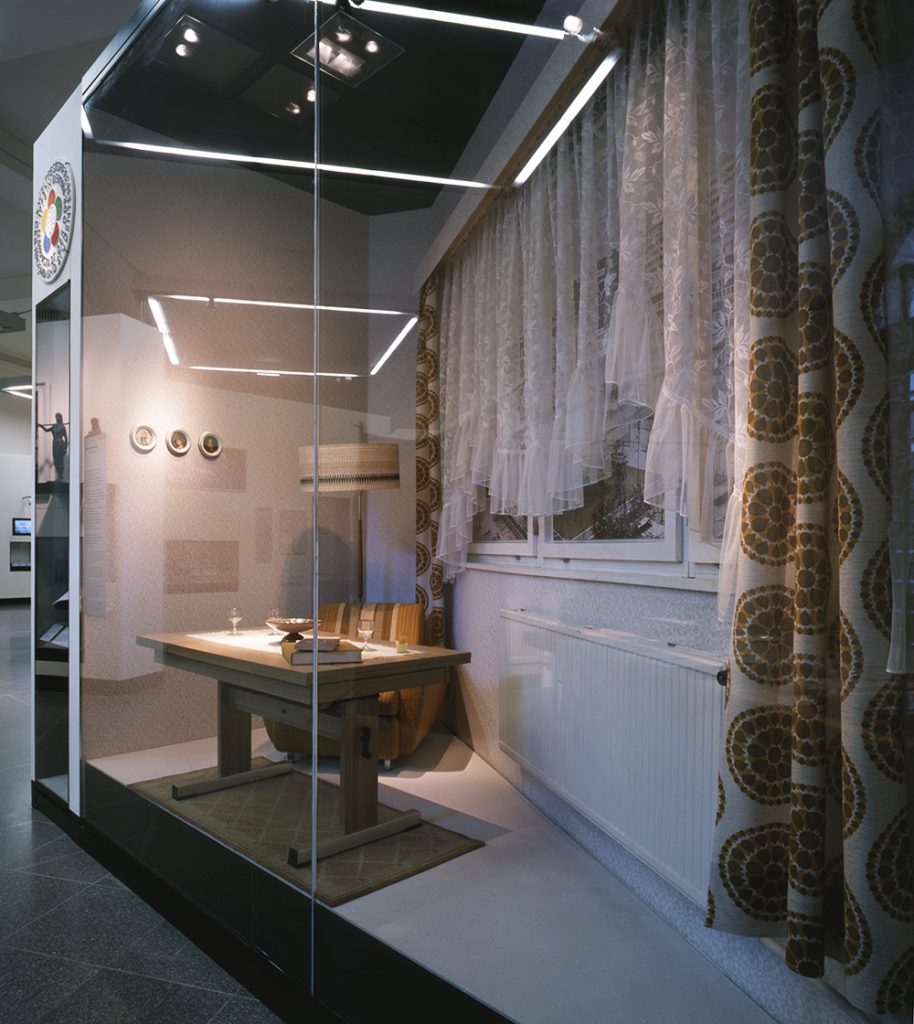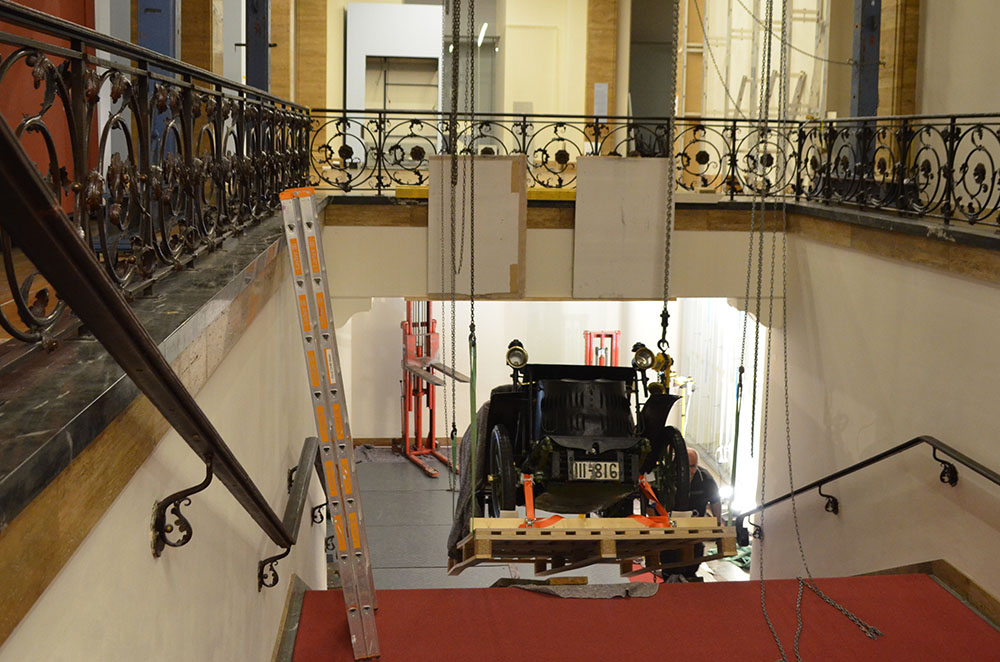
5 Questions for: Anna-Maria Gogonjan
9 December 2021
The Zeughaus, the Deutsches Historisches Museum’s main building, is currently closed for renovation and the permanent exhibition “German History from the Middle Ages to the Fall of the Berlin Wall” is being carefully dismantled and put into storage. At the same time, the DHM is busy working on plans for a new Permanent Exhibition – a major project affecting all departments across the museum. In our interview series „5 Questions for…“, we give museum curators and staff the chance to talk about their personal memories of the last permanent exhibition and what they are working on now. This time we talked with registrar Anna-Maria Gogonjan.
The permanent exhibition shut in late June. Although you’re still new at the DHM, was there a particular object or segment in it that sticks out in your mind?
Anna-Maria Gogonjan: The closing chapter on the divided Germany featured a period recreation of an East German living room. What surprised me most about it was that the scenography included a modular unit from a real block of flats in Marzahn, a Berlin district known for its many communist-era estates. I myself grew up in neighbouring Hellersdorf, in a prefab building [Plattenbau or just “Platte” for short] and it would never have occurred to me that a museum could also collect something like that. Especially nowadays, there are many stereotypes associated with the East German “Platte”.

In dismantling the permanent exhibition, what has been the biggest challenge for you? And what happens to the exhibits, especially to loans?
The biggest challenge is simply keeping track of everything. Taking the exhibits down is just half the story. The DHM has three different storage sites in Berlin, which house the objects from our different collection areas, of which there are eleven in all. But we can’t just pack our exhibits into ordinary boxes and crates – they are valuable cultural assets, many are irreplaceable. Professional art handlers carefully pack away each individual object, giving them optimal protection while in storage. It takes a lot of organization – yes, and discipline – to avoid getting things mixed up and not knowing where a particular object is at any given time. But because our team has so much experience in mounting and dismantling exhibitions, it wasn’t anything out of the ordinary and we just got on with it.
I’ll go through the procedure for you step by step. First, we take down all objects within the same material category. This means that conservators from the museum’s nine conservation departments go through each segment or chapter of the exhibition accompanied by a team of external museum technicians, removing, protocolling, and packing up exhibits. All small-scale objects, made, say, of wood – then in the next round of metal, then glass and ceramics, then all paintings – are packed away in separate “campaigns” by art-packing specialists. Many objects also require specially made transport boxes, crates, or transport frames. Other object types, such as paper objects, posters, and books are packed exclusively by the conservators from that department. It was then up to me to liaise with the other registrar on the project, Nina Bätzing, in organizing the transport to the storage sites. I was responsible for interfacing with the art shipping company, while Nina oversaw the trips made with the DHM’s own truck, which is driven by our warehouse assistants.
The permanent exhibition also featured 172 loans. It’s the museum registrars’ job to correspond in detail with the lenders and to oversee the dismounting, packing, and transport logistics of the loans. Before taking the display down, a few objects were requested as loans for temporary exhibitions by other museums. These objects had to be taken care of separately by the registrar for outgoing loans.

Another obstacle are the heavy goods – objects that cannot be easily removed, packed, and transported and which require special lifting equipment. There were 20 such objects in all. Lifting them off the presentation platforms requires outsourcing assistance from a company specializing in moving heavy goods with its own special cranes and lifts and the necessary staff to operate them. Thanks to the reinforced concrete floors, the museum was even able to display things like an early automobile by Maurer-Union or a steam engine by Bock on the first floor. We had to use a specially assembled platform lift to get them from the upper floor, down the flight of steps, and into the Zeughaus foyer, before loading them onto the truck or low-loader tailer. I was quite relieved that the head of conservation supervised the organization of these transports herself.
To give us an idea of the size and scale of the exhibition, how many objects, or rather how many cubic metres of history were moved with the dismantling of the exhibition?
Before it was dismantled, there were about 5,500 objects in the exhibition. However, that figure doesn’t include facsimiles and replicas. And in terms of cubic metres, well let’s just say it was the equivalent of about 70 truckloads – and that’s not counting additional trailers.
You were hired by the DHM specifically to dismantle the permanent exhibition. Have you supervised similar projects before? What makes this project so special and will you also be involved in installing the new permanent exhibition?
My last job was at the Jewish Museum, here in Berlin. In my first position there, as a student assistant, I helped dismantle the old permanent exhibition. And then I got the post of second registrar when their new permanent exhibition was installed. However, the permanent exhibition at the DHM was twice as big as the Jewish Museum’s in terms of floor space and the number of exhibits it featured.
What makes the DHM project particularly challenging, however, is the sheer number of objects, as well as the historical background – that and the enormous dimensions that you have to contend with in the case of some of the objects. I will probably also be involved in planning and preparing the new permanent exhibition and am already looking forward to its installation. Many of the staff currently involved in dismantling the last one are due to go into retirement, which means the team is changing.
Is there anything you think we should bear in mind when it comes to planning the new permanent exhibition?
While dismantling the last one, we noticed how important ease of handling is. In many cases, it was hard just to get to some of the objects, let alone move them. What we need are cabinets and presentation fixtures that are themselves easy to handle, otherwise it requires bringing in heavy equipment and special tools that are expensive and can only be operated by external staff.